Sewing
box Index

History of sewing
boxes
Request current
list of available sewing boxes
| |
Antique Fully fitted sewing box inlayed with
mother of pearl circa 1825.
Please click on images to enlarge | slide show | thumbnail index |
Reference: Sb488
Description:
SB488: A sewing box of impressive form, decoration and workmanship, the interior
lined with red silk and fully fitted with mother of pearl sewing tools, Circa 1825.
The box is veneered in saw-cut dark coromandel and inlaid in mother of pearl.
The box is shaped in the form favoured in the early part of the 19th century, the second phase of neoclassicism, which drew its references from the architectural traditions of Egypt and the near Middle East. The structure is carefully constructed, combining flat and tapering surfaces brought harmoniously together with cavetto moulding. The roundness of the moulding softens the lines and separates the decoration into two distinctive compositions.
The box stands on turned and carved feet which support a base edged in gadrooning. There is also gadrooning of an unusual pattern framing the top part of the box.
Origin: UK
Circa: 1825
Size: 31.2 cm wide by 23.5 cm by 18 cm: 12.3
inches wide
by 9.3 inches by 7.1 inches.
Condition: Good overall;
see photographs.
|
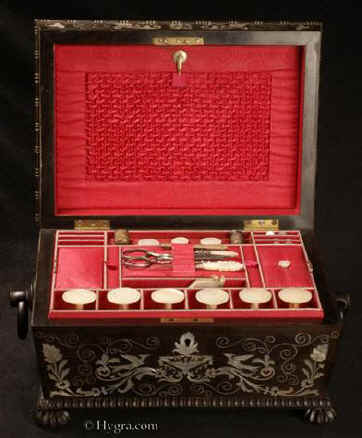
|

|
The box is veneered in saw-cut dark coromandel and inlaid in mother of pearl.
The box is shaped in the form favoured in the early part of the 19th century, the second phase of neoclassicism, which drew its references from the architectural traditions of Egypt and the near Middle East. The structure is carefully constructed, combining flat and tapering surfaces brought harmoniously together with cavetto
moulding. The roundness of the moulding softens the lines and separates the decoration into two distinctive compositions.
The box stands on carved feet which support a base edged in gadrooning. There is also gadrooning of an unusual pattern framing the top part of the box.
|
Please click on images to enlarge | slide show | thumbnail index |
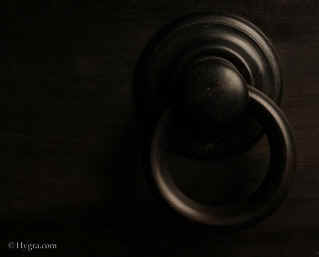
|
Side of the box showing the turned ring handle.
|
Detail of front showing the skilful incorporation of the escutcheon within the design.
|
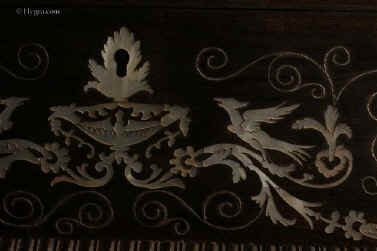
|
Please click on images to enlarge | slide show | thumbnail index |
Detail of left side of the design.
|
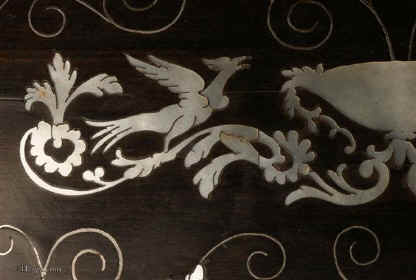
|
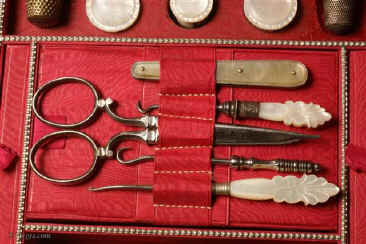
|
Detail showing the steel scissors and mother of pear handle tools.
|
Please click on images to enlarge | slide show | thumbnail index |
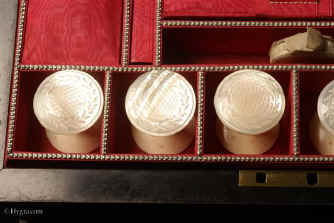
|
Detail showing the arrangement of the spools.
|
The finely ruched cover on the inside is in unworn condition.
|
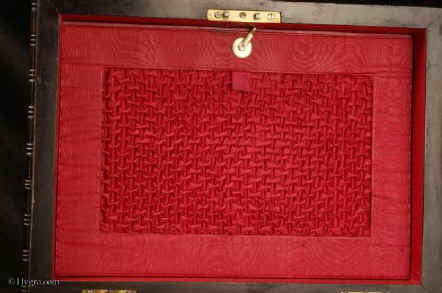
|
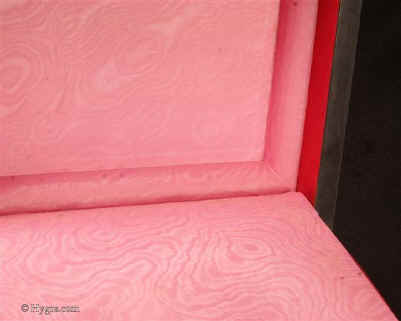
|
The ruched flap comes down to reveal an ‘envelope’ for storing designs, letters, etc., the whole covered in silk.
|
Please click on images to enlarge | slide show | thumbnail index |
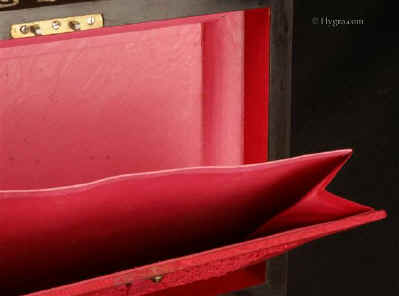
|
The ruched flap comes down to reveal an ‘envelope’ for storing designs, letters, etc., the whole covered in silk.
|
The spools are of exquisite design and very unusual in that they are finely engraved rather than carved. They are of the earlier period; the tops screw on the stems. There is also a waxer, a needle cleaner and a tape measure. There is also a small pin cylinder phased with engraved mother of pearl.
|
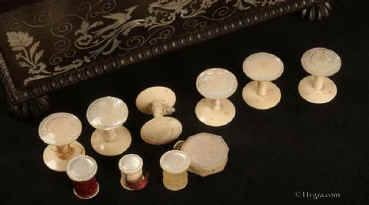
|
The spools are of exquisite design and very unusual in that they are finely engraved rather than carved. They are of the earlier period; the tops screw on the stems.
Detail of the spool top showing the design: a wreath of acanthus leaves, a motif of the ancient classical world.
|
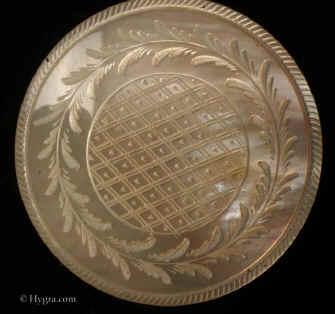
|
Please click on images to enlarge | slide show | thumbnail index |
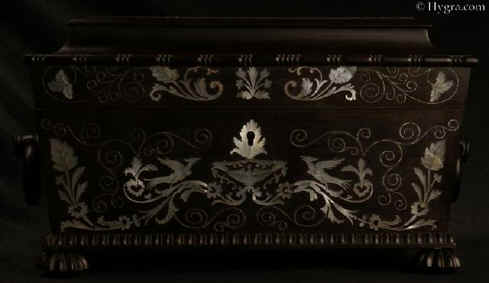
|
The design on the front is within the neoclassical tradition. It is controlled and symmetrical, showing two exotic birds facing each other on each side of a shallow urn. However, the stylised flowers and leaves, as well as the feathers of the birds, undulate in a vibrant way, suggestive of nature. The inlayer was a master of his craft as well as a true artist, who succeeded in shaping a hard material, mother of pearl, using small saws and files (you can see the cuts in enlargement) and inlaying it with incredible exactitude into a very hard wood. The looping lines are in white metal.
|
 (Small).JPG)
|
The other side showing the handle.
|
Please click on images to enlarge | slide show | thumbnail index |
Detail of foot.
|
 (Small).JPG)
|
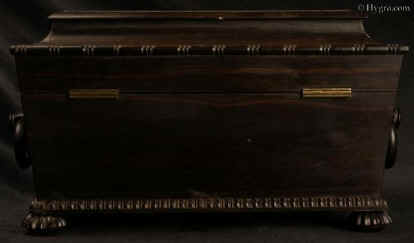
|
Back showing the strong double hinge and the continuation of gadrooning.
|
Please click on images to enlarge | slide show | thumbnail index |
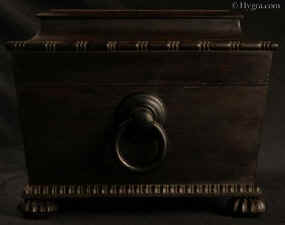
|
Side view.
|
The top of the box is inlaid in a design within the same tradition but treated differently, respecting its continuous shape. Whereas the front is more mother of pearl rich, in order to encompass the key hole and allow for the lid division, the top allows for a free flowing of undulating shoots, which gives it a lighter, more ethereal quality.
|

|
The interior is lined in silk.
|
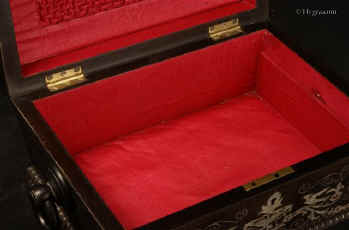
|
Please click on images to enlarge | slide show | thumbnail index |

|
Working lock and key. |

|
The bottom still retains the original paper. |
Please click on images to enlarge | slide show | thumbnail index |
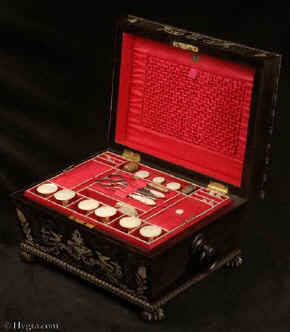
|
The box arranged showing also two thimbles of later manufacture. Thimbles being a personal item tend to change with owner.
|
All text and images and linked images are ©
1999-2010 Antigone Clarke and Joseph O'Kelly. If you require any further
information on permitted use, or a licence to republish any material, email us
at copyright@hygra.com
|
